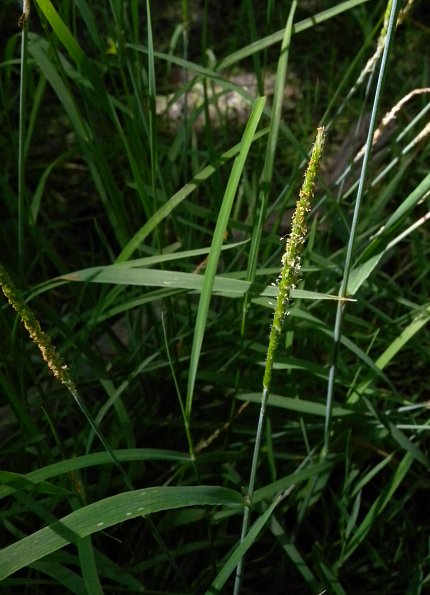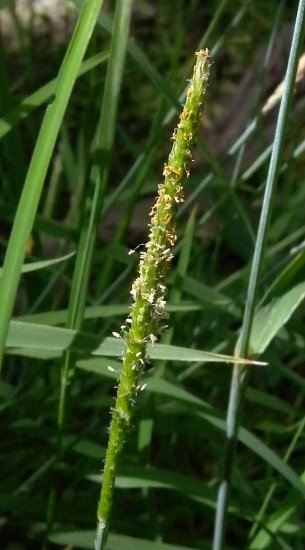
Each fertile culm terminates in a spike-like panicle that is about 1-3" long and 4-5 mm. in diameter; the panicle is narrowly cylindrical in shape and light green when it is immature. The single-flowered spikelets are densely arranged along the entire length of each panicle; they are overlapping, ascending, and soft. Each spikelet is about 2-3 mm. long with an ellipsoid shape that is compressed (flattened), consisting of a pair of glumes, a pair of lemmas, and a perfect floret. The glumes are keeled, where they are conspicuously ciliate; they are softly short-hairy below the middle and joined together at the base. The lemmas are glabrous and joined together at the base; the fertile lemma has a short awn that originates from below the middle of its length. This awn is exserted up to 1.0 mm. from the tip of the spikelet. The infertile lemma is similar in appearance to the fertile lemma, except that it lacks an awn. Both the glumes and lemmas are about the same length as the spikelet (excluding the awn). Each floret has 3 stamens and a pair of feathery stigmata; the anthers are pale yellow to orange. The blooming period occurs from late spring to mid-summer, lasting about 1-2 weeks. The florets are cross-pollinated by the wind. Fertile florets are replaced by small grains. The root system is shallow and fibrous.
 Colonies of plants often develop at favorable sites.
Colonies of plants often develop at favorable sites.Cultivation: The preference is full or partial sun, wet conditions (including shallow standing water), and mucky soil with decaying organic matter. This grass can tolerate shallow standing water during the growing season for up to 2 months. It has a C3 metabolism, preferring cool moist conditions for its growth and development.
Range & Habitat: The native Short-Awned Foxtail is uncommon in Illinois, occurring in scattered areas across the state (Distribution Map). In addition to North America, this grass also occurs in Eurasia. Habitats include prairie swales, edges of bogs, partially shaded seeps, swamps, low areas along ponds, and ditches. In Illinois, this grass usually occurs in higher quality natural areas, although it sometimes colonizes disturbed areas.
Faunal Associations: Very little is known about floral-faunal relationships for Short-Awned Foxtail and other members of its genus. Some common leaf beetles are known to feed on the foliage of these grasses, such as Myochrous denticollis (Southern Corn Leaf Beetle) and Oulema melanopus (Cereal Leaf Beetle). The young foliage is edible to cattle and other hoofed mammalian herbivores, but it becomes less palatable as it matures.
Photographic Location: A partially shaded seep at the Horseshoe Bottoms in Vermilion County, Illinois.
Comments: Even though they share the common name, 'Foxtail,' the cool-season Alopecurus spp. are quite distinct from the weedy warm-season Setaria spp. Sometimes the latter are referred to as 'Bristlegrasses' because their spike-like panicles can feel bristly and rough depending on the direction in which they are rubbed. In contrast, the spike-like panicles of Alopecurus spp. feel soft, regardless of which direction they are rubbed. Another species, Phleum pratense (Timothy), is a larger grass with spike-like panicles that are more stout; its panicles also feel more rough when they are rubbed. Short-awned Foxtail (Alopecurus aequalis) can be distinguished from other Alopecurus spp. by the its short awns, which are exserted no more than about 1 mm. from the tips of its spikelets. Other species of this genus that occur in Illinois have awns that are exserted 2.0 mm. are more from the tips of their spikelets. In addition, the spike-like panicles of these other species tend to be more stout (5.5 mm. or more in diameter).